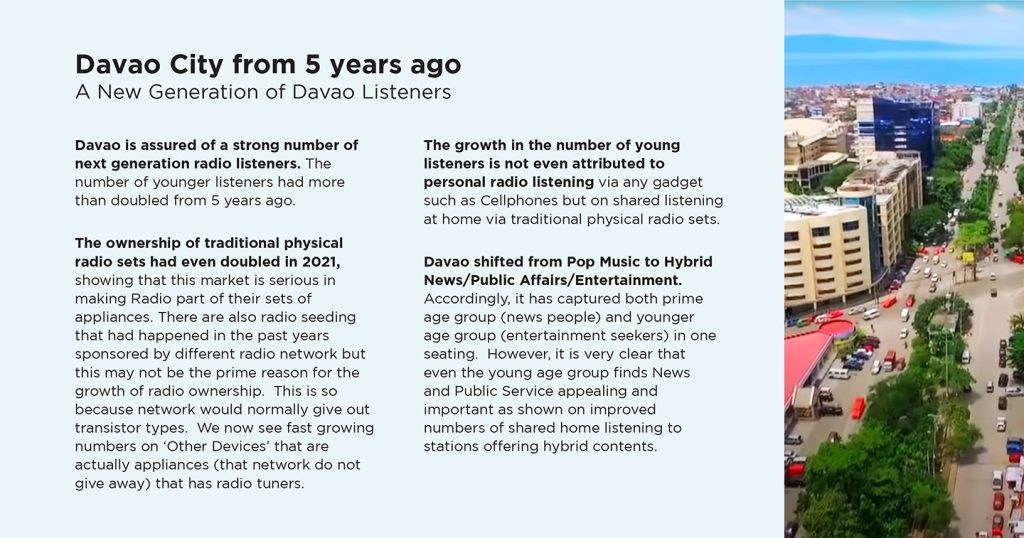MANILA, PHILIPPINES — With so many mediums making up today’s modern media landscape, data reports are necessary to understand how these platforms are affecting total media consumption. From audience numbers to consumer demographics, these are the kinds of trends and insights revealed in Kantar’s latest report.
Data insights and consulting company Kantar released “Radio and Its Relevance Today” and its latest global study report, “The Future Viewing Experience.” Each report dives into the numbers behind recent findings in consumer behavior and what it says about the future of media.
Shifts in radio habits in the metros
Kantar’s recent “Radio and Its Relevance Today” report focuses on three metros — Metro Manila, Metro Cebu, and Metro Davao — and the changes in radio consumption that have been observed in each one.
For Mega Manila, the year 2021 saw the continuation of a steep drop in radio ratings from the past four years. While it’s not unusual for any radio station to gain and lose listeners for a variety of reasons, such as promotion or competition within the medium, this significant drop in total radio must also be viewed in the bigger context of ABS-CBN’s Teleradyo and MOR leaving broadcast.
There’s also a matter of where audiences are listening to the radio nowadays. According to Kantar, the past four years have shown a decline in access to radio broadcasts via traditional physical radio sets. On the other hand, though, the last four years have also shown a steady rise in the use of appliances with built-in radio tuners.
A shift was also found in the radio listening habits of those in Metro Cebu. In particular, the study found that there has been a migration from AM to FM programming for News and Entertainment stories in the area. These numbers are likely directly related to the fact that there’s a dip in the popularity and access to traditional physical radio sets whereas more and more Cebuanos seem to be listening via multi-function devices and appliances which only has FM radio tuners.
Generally, though, the relevance of Radio in Metro Cebu seems to be secure, especially considering more Cebuanos in the 20 to 39 bracket are forming strong radio habits.
As for Davao City, there seems to be a new generation of radio listeners with their numbers growing. In the past five years, the number of young listeners has doubled. This is especially impressive seeing as these listeners don’t seem to be accessing the radio via other gadgets. In fact, in 2021, there was also a doubling of the ownership of traditional physical radio sets in the area.
Aside from the rise of young listeners, there has also been a shift from Pop Music to Hybrid News, Public Affairs, and Entertainment. This has captured the attention of both news people and entertainment seekers. It’s also shown in the improved numbers of shared home listening to stations with hybrid content that even younger age groups are listening to News and Public Service content too.
The digital space makes way for radio
A big change for radio as a whole is how it’s adapted to the digital space. According to Kantar, this is one of the reasons that Millenial and Gen Z audiences have become key drivers for at-home listening.
With the digital space came the opportunity to engage audiences beyond traditional listening. This led to online streaming of broadcasts that people could engage with on social media, and it also gives radio DJs the opportunity to take on the versatile role of influencers.
Kantar finds that with radio finding its next steps in the digital era, more listeners are bound to tune in.
The future of media
Kantar also recently released “The Future Viewing Experience,” a report that appraised the future of media delivery and the viewer experience and behavior. With the ever-changing landscape of media and entertainment, the need to anticipate what comes next in the industry and its implications for audience behavior becomes more evident.
Global brands take control
Kantar has found that larger media companies are moving towards vertical integration and creating more direct-to-consumer experiences. This means that global brands are seeking to take a more monolithic approach and control the whole chain, from the production of their content to the delivery to at-home viewers.
This is why many media companies have been ending deals with other distributors and viewing platforms. Big names like Disney, Paramount, and Discovery have taken to launching their own VOD services.
However, the viability of vertical integration and direct-to-consumer experiences is dependent on the intellectual property a media company owns. Hence, the fight for franchises continues. Disney is a major example of this as its venture into Disney+ was largely helped by the acquisitions — Pixar, Lucasfilm, and Marvel, to name a few — it has made throughout the years. Many toy and games franchises like Hasbro have also reported to be looking to expand to film and TV to make the most out of the brands they own.
With the data showing that global franchises are key to reaching global audiences, Kantar sees it as no surprise that media companies are looking to further expand their intellectual property and search for potential new franchises.
Harmonizing Smart TV ecosystems for advertising
Kantar has also found that the growing use of Smart TVs can pose more opportunities for the growth of addressable advertising. With Smart TVs’ omnichannel capabilities come new ways to innovate different forms of advertising. However, the report emphasizes that for connected and Smart TVs to truly revolutionize video advertising, a lot of work must be done to harmonize the ecosystem.
This is due to the range of fragmented operating systems that come with Smart TVs. These devices carry multiple services, each with its own login. Additionally, the complexity across apps and set manufacturers also make it difficult to buy and sell advertising.
“As in so many areas of media life, greater collaboration will be needed to really allow advertisers to fully exploit the opportunities around connected TVs,” said Kantar.

















